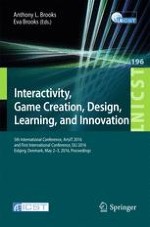2017 | Buch
Interactivity, Game Creation, Design, Learning, and Innovation
5th International Conference, ArtsIT 2016, and First International Conference, DLI 2016, Esbjerg, Denmark, May 2–3, 2016, Proceedings
herausgegeben von: Anthony L. Brooks, Eva Brooks
Verlag: Springer International Publishing
Buchreihe : Lecture Notes of the Institute for Computer Sciences, Social Informatics and Telecommunications Engineering
